Why Kitesurfing Booties Matter for Performance and Safety
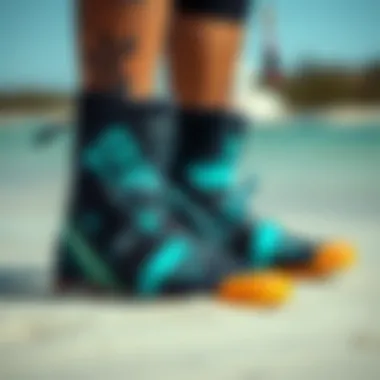
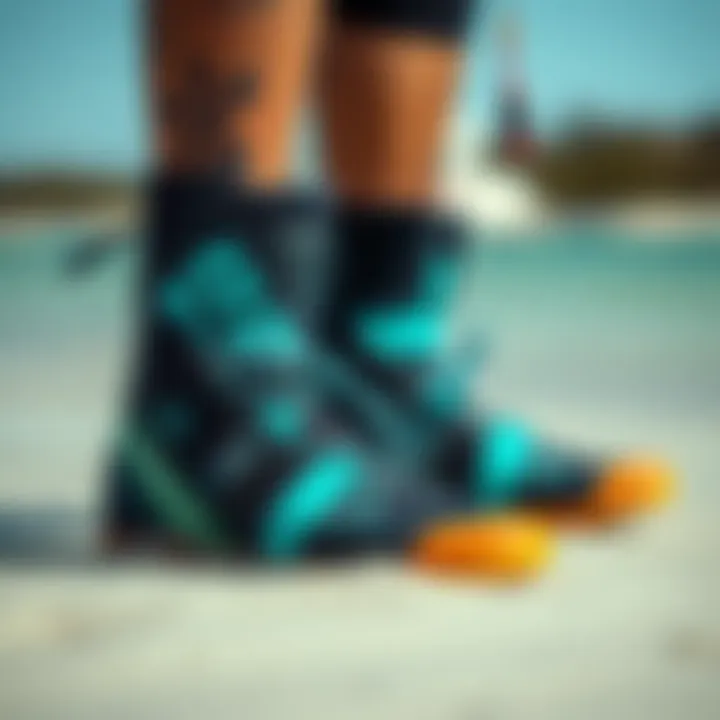
Intro
Kitesurfing, as a sport, blends the thrill of surfing with the power of the wind, offering enthusiasts an exhilarating connection to the water. However, beneath the joy of gliding across the surface lies an essential aspect often overlooked: the gear. Among the various pieces that equip a kitesurfer, booties hold a significance that's sometimes relegated to the background. Yet, these specialized shoes provide more than just protection—they enhance comfort during long sessions, ensure better foot gripping on the board, and can ultimately influence your performance.
In this journey through the realm of kitesurfing booties, we will explore their construction, the benefits they offer, types available on the market today, materials that make them durable, and care tips to maintain their utility. Whether you're a beginner stepping into this exciting world or a seasoned pro looking to upgrade your gear, understanding the impact of booties on your kitesurfing experience can be pivotal for your success on the water. Let’s dive into the details and uncover the often unnoticed yet pivotal role that kitesurfing booties play in the sport.
Understanding Kitesurfing Booties
Kitesurfing booties may often take a backseat to flashy boards and colorful kites, but their importance cannot be overstated. These specialized footwear items protect your feet from cold water, rocky shores, and the abrasiveness of equipment. While you may think that any old sneakers would do, the reality is that a dedicated pair of booties can enhance not only your comfort but also your performance on the water. Knowing their role helps to differentiate between a mediocre session and a stellar one.
The Role of Booties in Kitesurfing
Kitesurfing booties act as a shield against the elements and hazards. When you're out on the water with a stiff breeze and gusts that can take you off guard, the last thing you want is to feel discomfort or injury from rocks, coral, or cold water. Booties provide crucial insulation, allowing you to stay on the water for longer without succumbing to the chills.
Booties also offer grip. Standing on a slippery board can be treacherous, especially if you're just getting the hang of things. Quality booties will typically feature rubber soles that provide traction, keeping you steady so you can focus on your timing rather than worrying about taking a tumble. This stability is indispensable, particularly in challenging conditions where every maneuver counts.
In essence, booties are not just an accessory; they are a core part of kitesurfing gear that enhances safety and boosts overall confidence in the water.
Essential Features of Quality Booties
When it comes to selecting the right pair, not all booties are created equal. Here are some key features to look for:
- Material: Most booties are made from neoprene, known for its flexibility and warmth. Consider the thickness based on the water temperature you'll typically encounter.
- Fit: Booties should fit snugly without being too tight. A proper fit ensures that your feet remain warm and comfortable, allowing you to focus on enjoying the ride.
- Sole Design: A high-quality bootie will have a well-designed rubber sole that offers grip and flexibility. This enhances your connection to the board, making trick execution easier and safer.
- Insulation: Look for booties that provide good insulation options if you're kitesurfing in colder climates. This feature is vital for prolonged sessions, keeping your feet warm and your performance at its peak.
- Ventilation: Ventilation panels can be a plus, especially in warmer climates. They help reduce water retention and minimize the likelihood of awkward odors.
Selecting the right booties, featuring the characteristics outlined above, is paramount to ensuring an enjoyable kitesurfing experience. In the end, investing in quality gear allows you to focus on mastering your techniques rather than being distracted by discomfort.
Types of Kitesurfing Booties
Kitesurfing booties are not all cut from the same cloth. The variance in designs can significantly impact a kitesurfer's experience on the water. It is essential to comprehend the different types of booties available to make an informed choice that aligns with your needs. Depending on your riding style, local conditions, and personal preferences, the right bootie can enhance your performance and comfort. This section will explore three critical distinctions: strapped versus zippered booties, thin versus thick neoprene booties, and open-toe versus closed-toe booties.
Strapped vs. Zippered Booties
When considering kitesurfing booties, one might wonder whether to choose strapped or zippered styles. Strapped booties are often favored by riders who enjoy a snug fit and the flexibility of adjusting tightness. These booties typically have Velcro straps that can be easily modified. This feature allows for quick adjustments during a session, which can be a game-changer when the situations change, whether it’s a sudden shift in wind or an unexpected wave.
On the flip side, zippered booties offer a more convenient and secure fit, especially for those who are maneuvering in and out of them frequently. The zippers close and open smoothly, making it easier to slip on or off, but they can be a wee bit more cumbersome compared to straps during a session. Nevertheless, many riders find the added warmth of a zippered design highly beneficial, especially in colder waters.
"Choosing between strapped and zippered booties depends on preferences: comfort versus convenience."
Thin vs. Thick Neoprene Booties
Neoprene thickness is another defining aspect of kitesurfing booties. Thin neoprene booties, usually around 2 to 3 millimeters thick, are excellent for warmer water conditions. They provide enough protection against minor abrasions while allowing for flexibility and comfort. If you're the type that gets hot quick or predominantly rides in warm waters, thin booties might be your best bet.
Conversely, thick neoprene booties (approximately 4 to 6 millimeters) come into play for colder waters. They provide insulation, keeping your feet warm in chilly conditions while still ensuring a decent grip on your board. For those kitesurfers who find themselves in surf spots where the water temperature drops, investing in thicker booties is crucial. However, it’s worth noting that thicker materials can sometimes limit mobility, which could affect your performance during trick-heavy sessions.
Open-Toe vs. Closed-Toe Booties
The next point of consideration is whether to go for open-toe or closed-toe booties. Open-toe booties are mainly designed for warmer climates, allowing for breathability and a bit of airflow. They also allow for more flexibility, which can be perfect for those who enjoy the feeling of having their toes free while riding. However, on a flat day, stepping on a clam or shell can turn into a nasty surprise.
Closed-toe booties, on the other hand, provide extra warmth and a snug fit, keeping the elements out. This design also allows for better protection against protrusions in the water, providing peace of mind when navigating rocky areas or reef breaks. While they may trap heat in warmer conditions, many brands now offer ventilation features to help mitigate discomfort from overheating.
Choosing the Right Kitesurfing Booties
When it comes to kitesurfing, every piece of gear contributes significantly to your experience on the water, and booties are no exception. Choosing the right kitesurfing booties can seem daunting given the plethora of options available. A proper fit and appropriate materials ensure not only comfort but also performance, which can make all the difference in a session. Selecting the right booties directly affects your stability, comfort level, and even your safety while navigating the waves. In this section, we will explore the specific elements you need to consider in order to make a well-informed choice.
Factors to Consider
Water Temperature
Water temperature is a crucial aspect when selecting your kitesurfing booties. Different temperatures demand different types of insulation. Warm weather might call for thinner booties, as thicker materials can make your feet too warm and uncomfortable. Conversely, in cooler conditions, thick neoprene booties will not only keep your feet warm but also provide essential insulation from the cold water that can sap your energy and enthusiasm. The key characteristic of water temperature is its direct influence on your choice of booties; it can affect your stamina as you ride the waves.
Some riders prefer thicker booties for added buoyancy, which can be beneficial in colder waters, while others may opt for thinner models for agility and swift movements. However, wearing booties that are too thick in warm conditions can lead to sweating, which may ultimately cause discomfort. Therefore, understanding the temperature specificities of the locale where you ride is crucial to selecting the perfect pair.


Foot Size and Fit
Foot size and fit reflect a very personal aspect of bootie selection. Unlike many other pieces of gear, a snug and proper fit ensures that you maintain control during kitesurfing maneuvers. Booties that are either too loose or too tight can hinder performance or lead to foot pain, respectively. It’s imperative to consider that every brand might have different sizing, making trying them on an advantageous move.
Adding another layer, many advanced riders prefer a tighter fit for better board feel. However, a fit that is too tight can lead to discomfort across longer sessions. Hence, finding that sweet spot is necessary. The unique feature here is that getting the right fit can last and adapt; booties often stretch a bit after use, so one shouldn’t expect the first wear to represent the long-term feel. This fit ultimately leads to improved performance on the water.
Personal Preferences
Personal preferences also play an essential role in selecting the right booties. Some riders have firm opinions about open-toe versus closed-toe. Others are drawn to certain colors or designs that match their kitesurfing gear. Beyond aesthetics, personal comfort is paramount. Many surfers prioritize the feeling of being securely strapped in versus the versatility offered by an open design.
For instance, someone who prefers a high degree of foot dexterity might lean towards open-toe booties, allowing for better feedback from the board. However, closed-toe booties are often favored during colder months. The uniqueness of personal preference can significantly enhance or detract from the overall experience of kitesurfing; hence paying attention to these details is vital.
Common Mistakes in Selection
Selecting the right kitesurfing booties is often fraught with missteps. A common pitfall is prioritizing style over function, which can lead to dissatisfaction. Riders often forget to consider specific conditions such as sharp rocks or varying depths, thus opting for booties that do not adequately protect against these factors.
Furthermore, many tend to overlook the importance of trying on booties before purchase. Buying without testing fit can lead to a mismatch, resulting in pain or reduced performance during a session. Also, assuming a cheaper pair will suffice for every condition can be a costly error in the long run. A focused understanding of material, fit, and personal choice can prevent these costly mistakes, ultimately amplifying your kitesurfing experience.
The Materials Used in Bootie Construction
The choice of materials in kitesurfing booties goes beyond mere aesthetics; it plays a pivotal role in the performance and comfort they offer. Understanding the materials used in bootie construction is essential for making an informed decision when selecting the right pair. The right materials provide flexibility, warmth, and protection from the elements, which are critical for enhancing the kitesurfing experience. This section will delve into the two primary materials used in booties: neoprene and additional features like rubber soles and mesh panels.
Neoprene: Benefits and Limitations
Neoprene is the heart and soul of kitesurfing booties. This synthetic rubber, known for its versatility and durability, is prized for its insulating properties. When you’re out on the water, neoprene keeps your feet warm during those chilly morning sessions. The thickness can vary, so choosing between thin and thick options is often a matter of balancing warmth with mobility. Thicker neoprene provides better heat retention but may limit flexibility.
One of the limitations of neoprene is its breathability. Though it insulates well, it may not allow for adequate air circulation, leading to sweaty feet in warmer conditions. This can make for uncomfortable sessions if you're not careful—selecting booties with an optimal thickness, depending on the water temperature, is key. Moreover, while neoprene molds to your foot shape, it can, over time, wear out or degrade, especially if not properly cared for.
Additional Materials and Their Advantages
Rubber Soles
Rubber soles play a crucial role in the overall functionality of kitesurfing booties. A standout characteristic of rubber is its durability. It withstands abrasions and offers a dependable grip on the board. This grip is essential when you’re transitioning from water to board, preventing slips and stumbles.
The unique feature of rubber soles is their non-slip texture. This provides the rider with increased stability during maneuvers. Many riders prefer rubber soles because they contribute to a more confident riding experience. However, one needs to bear in mind that not all rubber soles are created equal. Some can be too rigid, potentially leading to foot fatigue over long sessions.
Mesh Panels
Mesh panels are another innovative feature that enhances the performance of kitesurfing booties. Their key characteristic lies in breathability. These panels allow airflow, which helps in regulating temperature and moisture. If your feet are breathing easy, you can focus more on your riding and less on discomfort.
The unique aspect of mesh panels is their quick-drying capability. They expel water rapidly, reducing the chances of discomfort or chafing after a wipeout. On the downside, while mesh increases breathability, it may compromise insulation. Thus, their effectiveness depends on the water conditions. If you’re riding in colder waters, it might be wise to opt for neoprene without mesh to maintain warmth.
"Selecting the right materials can make or break your kitesurfing experience. It’s not just about comfort; it’s about enhancing performance and enjoying the ride fully."
In summary, the materials used in bootie construction directly influence performance and comfort. Neoprene, rubber soles, and mesh panels all play distinct roles in ensuring that riders have the best possible experience on the water. By understanding the benefits and limitations of each, kitesurfers can make a more informed decision when selecting their gear.
Care and Maintenance of Booties
Taking proper care of kitesurfing booties goes beyond keeping them looking sharp. After all, these pieces of gear are not just for show; they play a crucial role in ensuring a safe and enjoyable kitesurfing experience. The maintenance routine can significantly extend the lifespan of your booties while enhancing their performance in the water. Knowing how to clean and store them correctly can be the difference between a good session and a flop.
Cleaning Procedures
Keeping your booties in top condition starts with a good cleaning regimen. Saltwater and sand can wreak havoc on neoprene, leading to degradation and unpleasant odors. Each session shouldn’t end just because you’re out of the water; it’s essential to rinse off your booties immediately after use. Here’s a quick guide for effective cleaning:
- Rinse Thoroughly: As soon as you're done, make it a habit to rinse your booties with fresh water. This simple step will help to remove salt, dirt, and sand that can cause wear over time.
- Use Mild Soap: If your booties are particularly grimy, using a mild soap commonly used for skin can do wonders. Avoid harsh detergents that can damage the material.
- Gentle Scrub: Utilize a soft brush or sponge to tackle stubborn spots. A gentle touch ensures you won’t harm the neoprene while cleaning.
- Dry Properly: After rinsing, let your booties air dry in a shaded area, keeping them away from direct sunlight, which can degrade the materials over time. You don't want them sitting in a damp pile; hanging them upside down can help retain their shape and avoid musty scents.
Taking time to care for your booties not only helps them look their best but also maintains their crucial protective features. After all, worn-out booties can lead to discomfort and even injuries in your sessions.
Storage Tips
Proper storage is just as important as cleaning when it comes to booties' longevity. A little bit of effort goes a long way when trying to keep them in great shape between those epic sessions. Here are some smart storage strategies:
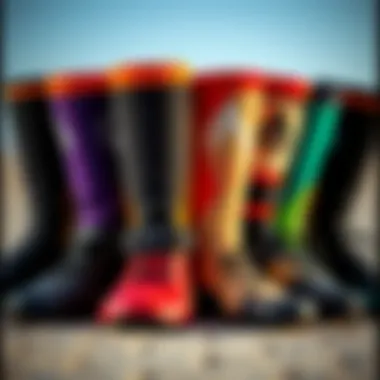

- Cool and Dry Location: Find a cool, dry place for storing your booties, such as a closet or a gear bag. Avoid areas with high humidity or excess moisture; mold can become a nasty surprise.
- Avoid Crushing: Don’t just toss them into a pile. Lay them flat or in a manner that doesn’t crumple or fold the neoprene. This keeps the material from losing its elasticity.
- Keep Away from Heat Sources: Ensure your booties are stored away from heaters or hot areas. Heat can cause neoprene to warp or lose its flexibility, undermining their protective qualities.
- Use Booties Bags: When traveling, place your booties in a breathable bag. That way, they can dry and prevent any mildew from setting in after a long kitesurfing trip.
Storing your booties right means you won’t face unpleasant surprises when you go to grab them for your next outing. Combine smart storage practices with routine cleaning, and your booties should serve you well throughout the seasons.
"The longevity of your gear is a reflection of how you treat it. A little effort on your part goes a long way."
For more information on proper gear care, you can check resources from established organizations like the American Society for Testing and Materials or community-driven insights on Kitesurfing Reddit.
By focusing on cleaning and storage, you're not only investing in your kitesurfing experience but also safeguarding your feet and enhancing performance.
The Impact of Booties on Performance
When it comes to kitesurfing, the gear we choose has a significant impact on our experience. Kitesurfing booties, although often overlooked, play a pivotal role in enhancing performance on the water. Their design and construction can directly affect a rider's ability to maneuver, maintain stability, and remain comfortable throughout a session.
Influence on Stability and Control
Booties provide essential grip and traction while on the board, which is vital for maintaining control. When the waves get choppy or the wind picks up, having the right booties can be the difference between a successful ride and a rough tumble into the water. A well-designed sole can increase friction against the board, allowing the rider to push harder and turn sharper without worrying about slipping.
Moreover, the thickness of the booties also influences how much feedback a rider gets from the board. Thinner booties often provide better board feel, as they allow maximum sensitivity to the board's movements. Conversely, thicker booties may offer additional warmth or foot protection but can dull the rider’s perception of the board. Finding a balance according to the riding style and conditions is hence pivotal.
"The right booties not only protect your feet but also enhance your connection with the board, allowing for smoother transitions and sharper turns."
Enhancing Overall Comfort During Sessions
Comfort cannot be overlooked while kitesurfing, especially during long sessions. Booties that fit well and are made from appropriate materials can significantly improve the overall riding experience. If a rider's feet are cold, sore, or cramped, their focus will shift from enjoying the ride to merely enduring it.
Neoprene, commonly used in booties, provides warmth and flexibility. Different thicknesses of neoprene cater to various water conditions. Additionally, quality booties feature seams that are either flat-lock sewn or glued and blind-stitched to reduce chafing and discomfort, further enhancing comfort during lengthy sessions. Riders often appreciate booties with added features like drainage holes, which prevent water from pooling inside, keeping their feet dry and comfortable.
Ultimately, well-chosen booties keep riders warm, stable, and focused on the thrills of kitesurfing rather than battling discomfort, which can easily distract from the enjoyment of the sport.
Innovations in Bootie Design
In the ever-evolving world of kitesurfing, one area that has seen significant advancements is bootie design. Innovations in this field not only address comfort and safety but also enhance performance during those exhilarating rides across the waves. Understanding these developments is crucial if you want to make the most out of your time on the water.
Advancements in Neoprene Technology
Neoprene has long been the go-to material for various water sports gear, but recent advancements have taken its properties to new heights. Modern kitesurfing booties use advanced neoprene blends that offer greater flexibility while maintaining thermal insulation. This means riders can enjoy impressive mobility without sacrificing warmth, a balance that's crucial when conditions get chilly.
Some brands have adopted high-stretch neoprene, which contours to the foot for a snug fit. This snugness reduces water entry, keeping feet warmer and drier. Plus, these new blends often have a softer feel, making it easier to perform intricate maneuvers without feeling constricted. Selecting booties with this technology can give you a leg up (or should we say foot up) on the competition.
Additionally, certain manufacturers have invested in eco-friendly neoprene options. As sustainability gains traction in the sport, using recycled materials not only reduces environmental impact but also ensures that kitesurfers can feel good about their gear.
"Technological progress in neoprene is at the forefront of elevating our game, bridging comfort and performance for the modern kitesurfer."
The Role of Technology in Performance Enhancement
Performance in kitesurfing is all about the rider's connection to the board and the water. Innovations in bootie design have a significant role in strengthening that connection. For instance, anti-slip sole technology has revolutionized the grip of kitesurfing booties. These soles often use unique tread patterns combined with rubber compounds, ensuring that the rider maintains a solid grip even in the most slippery conditions.
Moreover, some booties now incorporate smart technology that monitors foot temperature and provides feedback to the user. While this may still be in its infancy, the potential to enhance comfort through temperature regulation can lead to longer and more enjoyable sessions. Imagine a bootie that alerts you when your toes are getting a bit too cold—now that's innovation at its best.
Another notable enhancement is the integration of reinforced stitching methods. These advancements improve durability, ensuring that booties withstand wear and tear while still providing a comfortable fit. By choosing booties featuring these technological advances, kitesurfers can focus more on their performance and less on worrying about their gear.
Innovations in bootie design have greatly enhanced the kitesurfing experience, proving that what you wear on your feet can make all the difference in your ride. Riders are encouraged to embrace these advancements, aligning their gear with the demands of modern kitesurfing.
Kitesurfing Booties for Different Skill Levels
Understanding the various needs of kitesurfers at different stages of their journey is vital when it comes to choosing the right booties. The significance of booties in the sport cannot be overstated. They not only serve as protective gear but also play an immense role in comfort and performance. Choosing suitable booties that align with one’s skill level ensures safety and allows for a more enjoyable experience on the water. The selection process doesn't just depend on personal choice but also on environmental factors and individual proficiency in kitesurfing.
Booties for Beginners
For those new to the art of kitesurfing, selecting suitable booties is a monumental step. Beginner-friendly booties often focus on comfort and ease of use. Here’s what you should keep in mind when selecting booties as a novice:
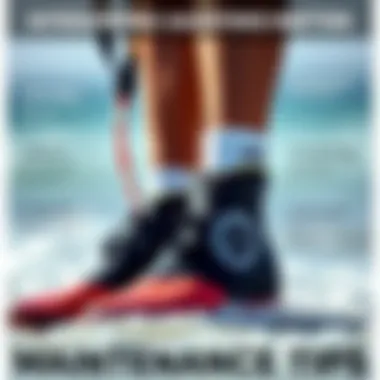
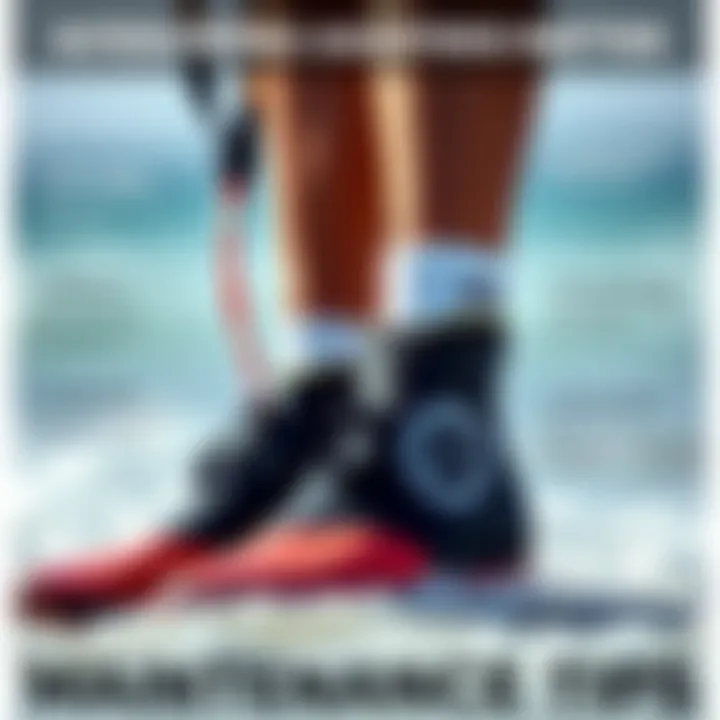
- Thicker Neoprene Material: A thicker layer provides added warmth and cushioning, reducing the chance of injuries.
- Open-Toe Designs: These designs are generally easier to put on and take off. They also allow for better ventilation on warm days.
- Good Traction: Opt for booties with rubber soles that provide traction. This will help you maintain a grip on your board, especially during those first few wobbly tries.
- Adjustable Straps: A snug fit is necessary. Booties with adjustable straps help ensure they stay put, giving you confidence as you learn.
As a novice, the ultimate goal is to stay comfortable while learning the ropes. If booties feel too tight or awkward, it can detract from the learning experience. Hence, finding the right fit is paramount.
"Comfort at the start can turn into confidence on the water."
Advanced Booties for Expert Riders
Once the kitesurfing bug bites, many enthusiasts strive to hone their skills and achieve expert levels. Advanced kitesurfers, unlike beginners, often look for performance-oriented features in their booties to elevate their riding experience. Some characteristics worth considering for high-level booties include:
- Lightweight Build: The lighter the booties, the better the performance. Advanced riders who engage in high-speed tricks will benefit from a design that offers minimum bulk while maximizing flexibility.
- Closed-Toe Options: These typically provide more support and warmth, which can be crucial during extended sessions in cooler waters.
- Reinforced Areas: Special support zones along the sides and soles are beneficial in withstanding impacts during jumps or landings.
- Enhanced Grip and Flexibility: Make sure to look for booties that allow for ample movement while maintaining excellent grip on the board.
- Durability: Racing through waves comes with wear and tear. Investing in booties made with high-quality materials ensures longevity.
Athletes at this level should be aware of how booties can permit or prevent certain maneuvers. Hence, selecting the right pair is not just about comfort, but it also affects performance metrics, such as speed and control in the water.
Being attuned to the differences in bootie design for beginners and experts is key in ensuring that every ride is not just safe, but also enjoyable and exhilarating.
Regional Considerations for Bootie Selection
When it comes to selecting the right kitesurfing booties, understanding regional variations can be a game-changer. Each location presents unique challenges, whether it’s the temperature of the water or the types of conditions a surfer might face. Choosing the appropriate booties based on your region can enhance comfort, boost performance, and, crucially, provide the protection needed while navigating diverse environments.
Cold Water vs. Warm Water Regions
The difference between cold and warm water kitesurfing experiences significantly influences bootie selection. In colder waters, where temperatures can drop significantly, thicker neoprene booties which typically range from 4mm to 6mm become crucial. These booties not only provide insulation against the chilly elements but also feature sealed seams to minimize water entry, keeping feet warm during prolonged sessions.
Conversely, in warmer waters, where temperatures are generally milder, say around the 70-degree mark, thinner booties work just fine. A 2mm or even 3mm bootie might be all that’s needed, offering enough protection from sharp objects while maintaining breathability to prevent overheating.
To illustrate, a kitesurfer in the icy waters of Iceland would seek a different bootie than someone shredding waves in the Caribbean. The former might focus on warmth and overall fit, while the latter could prioritize flexibility and comfort for longer sessions.
- Cold Water Booties Might Feature:
- Warm Water Booties May Include:
- Thicker neoprene for insulation.
- Insulated linings to retain warmth.
- Rubber soles for grip on rocky shores.
- Lighter, thinner neoprene for flexibility.
- Mesh panels for quick drying.
- Open-toe designs for better air circulation.
Climate Impact on Material Choice
The climate directly influences the materials utilized in bootie construction. In regions where humidity is high, like tropical areas, breathability of the booties takes precedence. Materials that enable quick drying and air circulation can prevent moisture build-up, keeping feet comfortable and reducing the risk of blisters.
In contrast, in drier and colder climates, booties might rely on more insulated and moisture-locking materials. Booties designed for these areas often include features designed to resist winds and keep heat within, focusing on comfort against colder conditions.
For instance, a kitesurfer in a coastal region facing blistering sun and sandy shores might opt for booties with UV protection and lightweight materials. However, someone surfing in a breezy bay prone to chills may prioritize thicker, more protective booties that can withstand cold winds.
In summary, whether navigating warm turquoise waves or bracing against frigid coastal gales, tailoring your bootie selection to regional specifications greatly impacts your kitesurfing experience.
Ultimately, making a thoughtful decision regarding booties based on your local environment promotes not just comfort but also enhances safety and performance.
Resources to explore for further insights include Wikipedia’s Kitesurfing page or Britannica for detailed articles on water sports.
Finale
Kitesurfing is not just a sport; it's an exhilarating pursuit that demands both skill and the right equipment. Among the most essential yet often overlooked pieces of gear are the booties. This article has aimed to shed light on the significance of kitesurfing booties, showcasing how they contribute not only to safety but also to overall performance. Understanding and selecting the right booties is as crucial as mastering the techniques of kitesurfing itself.
Summarizing Insights
Delving into the various aspects of kitesurfing booties has highlighted several key points:
- Protection: Booties safeguard feet against sharp objects, rocks, and changing water temperatures. This is especially relevant for those who navigate through a range of conditions, whether in tropical waters or harsher environments.
- Comfort: The right fit and material contribute greatly to how enjoyable a session on the water can be. Comfortable booties enhance foot flexibility, allowing riders to focus more on their maneuvers rather than discomfort.
- Performance Enhancement: Quality booties allow for better foot control, influencing stability and overall maneuverability on the board. This can be a game changer, particularly for those pushing their limits.
"A good pair of booties is like a sturdy anchor; it keeps you grounded while you ride the waves of adventure."
Choosing booties shouldn't be a hasty decision. Factors like water temperature, personal fit, and individual riding style should play a pivotal role in any selection process.
Future of Kitesurfing Booties
As kitesurfing continues to evolve, so does innovation in bootie design. Some emerging trends to keep an eye on include:
- Sustainable Materials: With the environmental concerns facing our planet, companies are beginning to explore eco-friendly alternatives in bootie manufacturing. This not only benefits our oceans but may also lead to enhanced performance with lightweight materials.
- Smart Technology Inclusions: Imagine booties that can adapt to water temperature or adjust grip based on conditions; technology could revolutionize how kitesurfers interact with their environment.
- Custom Fit Technology: Brands are experimenting with 3D printing and custom molds that promise a personalized fit, addressing one of the most common complaints among riders.
With each innovation, the potential for boosting performance and safety on the water increases. So as you dive into the exciting world of kitesurfing, remember that a solid pair of booties is more than mere footwear; it's an investment into your sport and your enjoyment.







